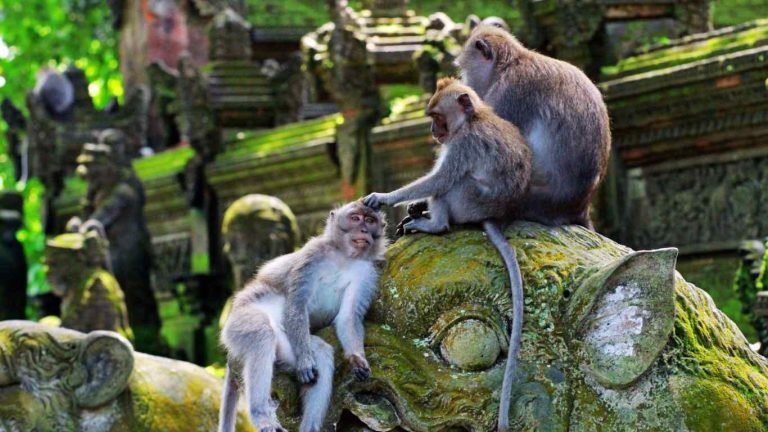Ancient Nine-Spout Spring Temple Fuels Gerih Village’s Sacred Purification Rites
Beji Pura Taman Langse sits in Gerih Village, Badung Regency, as one of the region’s oldest water shrines. Its origins span centuries. Since its stonework dates to a distant past, no formal records or village archives log its foundation, leaving exact dates a mystery. Oral tradition in Gerih holds that this spring-fed temple existed long before officials built Kahyangan Tiga Temple, once relied on as Gerih’s main purification well. Contrasting accounts claim Beji Pura Taman Langse and Kahyangan Tiga rose at the same time to serve cleansing ceremonies for pralingga or petapakan. Decorative carvings and the pond layout echo early Balinese design, but no one can identify the original creator. Villagers pass down versions of its legend, each adding layers to the site’s lore.
Its current name derives from the nine spouts that feed the temple’s pool. In Balinese, nine translates to ‘Sia,’ so villagers once called it Beji Pura Taman Lansia during temple gatherings. As writing and signage spread across the region, the pronunciation shifted to Beji Pura Taman Langse. That version now appears in most local records and on directional signs. The shift reflects natural language evolution and the move from oral tradition to formal documentation.

During ceremonies, the Gerih Adat Village community directs prayers to Ida Bhatari Gangga, believed to dwell within the water source. The main structure in this south-facing complex is Pelinggih Lanang Wadu, a shrine where couples seek blessings for children. Adjacent stands the Candi Petak, a square stone sanctuary typical of Balinese water temples. On its flanks are statues of Widiadara and Widiadari. Two bull figures, Lembu Lanang and Lembu Istri, watch over the pond. Each Pelinggih Lanang Wadu features intricate motifs carved into its roof and walls, reflecting local craftsmanship. High on the inner terrace, Bhatara Dewi Danu maintains a separate sanctum known as Gedong Sari. At the outer entrance, two lion statues—Macan Lanang to the south and Macan Istri to the north—guard the sacred grounds.
Local families and smaller temples without designated spring gardens draw on the flow from Beji Pura Taman Langse for holy water in their puja rooms and family shrines. Not every place of worship in Gerih Village requests water from this source; sanctuaries with established on-site water gardens generally have no need to send members here. This practice shows how each temple appreciates nearby resources.
Beyond daily distributions, Gerih’s adat community honors Piodalan at Langse each Purnama Kapat, marking the temple’s annual birthday. On Tawur Kesanga—the day before Nyepi—priests and devotees return for Melasti, washing sacred objects in the temple’s pond. Once every three years, the ceremony moves to the shoreline, but annual gatherings at Langse remain central. Pilgrims bring special vessels for tirta, and village elders teach proper etiquette, from stepping barefoot over thresholds to chanting mantras before drawing water. Some arrive on foot, others by car, carrying containers that range from brass cups to plastic jugs. Children often assist elders, carrying water back to remote hamlets and learning the rites through practice. Village leaders stress that performing Melasti at the beach or at Langse offers equal merit, since both rituals wash away impurities. This annual cycle not only reinforces communal bonds but also educates younger generations in environmental stewardship and respect for natural springs.

Just southeast of the main pond stands a pair of shrines dedicated to Bhatara Wisnu and Pancoran Pemanahan. The Wisnu sanctum lies inside the Beji Pura Taman Langse compound, and the Pemanahan spout falls under the care of a separate temple priest. During Melasti, worshippers gather at the Wisnu shrine to collect blessed water, but the Tirta Pemanahan spout serves a different purpose. That crystal-clear stream supplies water for Ngaben ceremonies, the Balinese cremation rite. In that context, Ida Pedanda Sang Muput uses this water to anoint offerings and complete the final purification before the body returns to its ancestral realm.
Beji Pura Taman Langse has long been connected to Pura Taman Ayun. According to Ida Bagus Oma from Gulingan Village in Mengwi, the lake at Taman Ayun was designed as a scaled imitation of the Langse pool. To visiting scholars and locals alike, Langse resembles a smaller Taman Ayun, though Gerih’s spring temple stands on older foundations. Longtime residents note similar carved motifs in both sites, reinforcing the village’s association with the Mengwi ruling family. Folklore holds that artisans traveled between the two shrines, bringing measurements and sacred water samples so each pool met precise ritual standards.
Just beyond the temple walls, a natural spring flows year-round, supplying the people of Desa Adat Gerih with fresh water for countless daily tasks. Villagers approach the site with reverence, using its cool stream for bathing, drinking, and washing clothes or kitchen tools. That shared resource strengthens the bond between humans and the land. In Gerih, water drawn here is useful and sacred, reflecting centuries of cultural and spiritual traditions. Community guidelines divide tasks: women typically handle laundry at designated stones, and men often fetch drinking water from specific pools. Children often fetch water as part of daily rites, offering petals at the pool’s edge to honor the spring spirit.
Seasonal weather and rainfall patterns affect the spring’s output, so the temple pond sometimes recedes during dry spells or floods in the outer spring. When water in Beji Pura Taman Langse drops, villagers turn to the external spring as a substitute. That stream can serve ritual needs just as well, providing holy water for ceremonies when the main pond falls low. This backup supply ensures that purification rites and daily offerings proceed without interruption, even under shifting natural conditions.
Spiritual guidelines governing the spring emphasize purity. Many villagers believe that the external stream may slow or stall if someone in an unclean state—especially a woman during menstruation—steps into the sacred area. There is also a widespread view that pregnant women should not enter Beji Pura Taman Langse. Though these practices lack scientific proof, they form part of deeply held ritual customs. Like many oral traditions, their validity rests on personal and communal conviction, varying from one family or priest to another. Some elders warn that breaking these taboos brings misfortune or sickness. Younger villagers may question the rules, seeking a balance between tradition and modern life.







